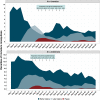Influence of larval growth and habitat shading on retreatment frequencies of biolarvicides against malaria vectors
- PMID: 38200070
- PMCID: PMC10781946
- DOI: 10.1038/s41598-024-51152-1
Influence of larval growth and habitat shading on retreatment frequencies of biolarvicides against malaria vectors
Abstract
Effective larviciding for malaria control requires detailed studies of larvicide efficacies, aquatic habitat characteristics, and life history traits of target vectors. Mosquitoes with brief larval phases present narrower timeframes for biolarvicidal effects than mosquitoes with extended periods. We evaluated two biolarvicides, VectoBac (Bacillus thuringiensis israelensis (Bti)) and VectoMax (Bti and Bacillus sphaericus) against Anopheles funestus and Anopheles arabiensis in shaded and unshaded habitats; and explored how larval development might influence retreatment intervals. These tests were done in semi-natural habitats using field-collected larvae, with untreated habitats as controls. Additionally, larval development was assessed in semi-natural and natural habitats in rural Tanzania, by sampling daily and recording larval developmental stages. Both biolarvicides reduced larval densities of both species by >98% within 72 h. Efficacy lasted one week in sun-exposed habitats but remained >50% for two weeks in shaded habitats. An. funestus spent up to two weeks before pupating (13.2(10.4-16.0) days in semi-natural; 10.0(6.6-13.5) in natural habitats), while An. arabiensis required slightly over one week (8.2 (5.8-10.6) days in semi-natural; 8.3 (5.0-11.6) in natural habitats). The findings suggest that weekly larviciding, which is essential for An. arabiensis might be more effective for An. funestus whose prolonged aquatic growth allows for repeated exposures. Additionally, the longer residual effect of biolarvicides in shaded habitats indicates they may require less frequent treatments compared to sun-exposed areas.
© 2024. The Author(s).
Conflict of interest statement
The authors declare no competing interests.
Figures




Similar articles
-
Efficacy and persistence of long-lasting microbial larvicides against malaria vectors in western Kenya highlands.Parasit Vectors. 2018 Jul 31;11(1):438. doi: 10.1186/s13071-018-3009-z. Parasit Vectors. 2018. PMID: 30064498 Free PMC article.
-
Evaluation of the effectiveness of Aquatain, Bacillus thuringiensis var. israelensis, and Temephos on Anopheles arabiensis and Anopheles stephensi larvae in the laboratory and field settings.Parasit Vectors. 2025 Jun 17;18(1):223. doi: 10.1186/s13071-025-06765-4. Parasit Vectors. 2025. PMID: 40528257 Free PMC article.
-
Wide-scale application of Bti/Bs biolarvicide in different aquatic habitat types in urban and peri-urban Malindi, Kenya.Parasitol Res. 2011 Jun;108(6):1355-63. doi: 10.1007/s00436-010-2029-1. Epub 2010 Aug 21. Parasitol Res. 2011. PMID: 20730445
-
Bacterial larvicides used for malaria vector control in sub-Saharan Africa: review of their effectiveness and operational feasibility.Parasit Vectors. 2019 Aug 30;12(1):426. doi: 10.1186/s13071-019-3683-5. Parasit Vectors. 2019. PMID: 31470885 Free PMC article. Review.
-
Biolarvicides in vector control: challenges and prospects.J Vector Borne Dis. 2003 Mar-Jun;40(1-2):20-32. J Vector Borne Dis. 2003. PMID: 15119068 Review.
Cited by
-
Analysis of the 24-h biting patterns and human exposures to malaria vectors in south-eastern Tanzania.Parasit Vectors. 2024 Oct 30;17(1):445. doi: 10.1186/s13071-024-06521-0. Parasit Vectors. 2024. PMID: 39478627 Free PMC article.
-
Mosquito control by abatement programmes in the United States: perspectives and lessons for countries in sub-Saharan Africa.Malar J. 2024 Jan 4;23(1):8. doi: 10.1186/s12936-023-04829-3. Malar J. 2024. PMID: 38178145 Free PMC article. Review.
-
Assessing the role of community involvement and capacity building in larviciding applications for malaria control in Africa: A scoping review.Curr Res Parasitol Vector Borne Dis. 2025 Aug 14;8:100307. doi: 10.1016/j.crpvbd.2025.100307. eCollection 2025. Curr Res Parasitol Vector Borne Dis. 2025. PMID: 40893609 Free PMC article. Review.
-
Evaluation of a long-lasting microbial larvicide against Culex quinquefasciatus and Aedes aegypti under laboratory and a semi-field trial.Parasit Vectors. 2024 Sep 14;17(1):391. doi: 10.1186/s13071-024-06465-5. Parasit Vectors. 2024. PMID: 39272177 Free PMC article.
References
-
- WHO. World Malaria Report 2022 (2022).
MeSH terms
Grants and funding
LinkOut - more resources
Full Text Sources
Medical

